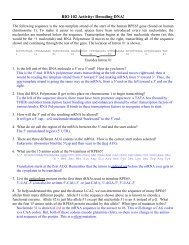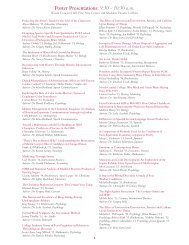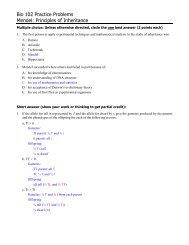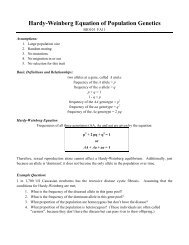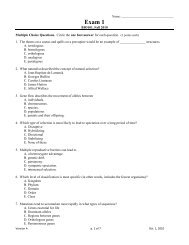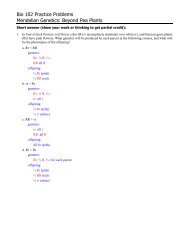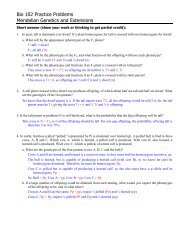BIO101 Lab 3 Bacteria Enumeration Pre-Lab Exercise: ⢠Read the ...
BIO101 Lab 3 Bacteria Enumeration Pre-Lab Exercise: ⢠Read the ...
BIO101 Lab 3 Bacteria Enumeration Pre-Lab Exercise: ⢠Read the ...
- TAGS
- bacteria
- enumeration
You also want an ePaper? Increase the reach of your titles
YUMPU automatically turns print PDFs into web optimized ePapers that Google loves.
<strong>BIO101</strong> <strong>Lab</strong> 3 <strong>Bacteria</strong> <strong>Enumeration</strong><strong>Pre</strong>-<strong>Lab</strong> <strong>Exercise</strong>:• <strong>Read</strong> <strong>the</strong> “Measurements and Solutions” (pg. 67-69) , “Making a Streak Plate” (pg. 74-76),and “Using Micropipettors”(pg. 77-79) sections of <strong>the</strong> Biology Student Handbook• Answer <strong>the</strong> following questions in your lab notebook:o How can we test <strong>the</strong> accuracy of a micropipette?o After plating your bacteria, why does each colony count as one cell?o What is <strong>the</strong> purpose of “bracketing” your dilutions?Introduction:As part of <strong>the</strong>ir daily routine, <strong>the</strong> microbiologist often has to determine <strong>the</strong> number ofbacteria in a given sample, as well as having to compare <strong>the</strong> amount of bacterial growth undervarious conditions. <strong>Enumeration</strong> of microorganisms is especially important in medical microbiology,food and diary microbiology, and environmental microbiology.Concentrations of bacteria cells in samples are usually too great to be counted directly.Simple dilutions are practical when <strong>the</strong> dilution factor is about 100-fold or less. If <strong>the</strong> number ofbacteria in a given sample is too great to be counted using a simple dilution, <strong>the</strong> sample is oftenserial diluted. Serial dilutions are a progressive series of dilutions. The final dilution is <strong>the</strong>n platedout on an agar surface in such a manner that single isolated bacteria form visible isolated coloniesthat can be counted. The concentration of <strong>the</strong> original sample can <strong>the</strong>n be back calculated based on<strong>the</strong> serial dilutions.In our experiment, we want to determine <strong>the</strong> concentration of bacteria in our culture. Wedon’t know <strong>the</strong> actual concentration, but it is highly concentrated, on <strong>the</strong> order of 1 x 10 8 cells/mL.To get a countable number of colonies on our plates we want our 0.1mL sample to be at aconcentration of approximately 1 x 10 2 cells/mL. This is a one million-fold dilution – clearly too bigto do at once. We will solve this problem by doing a serial dilution.Calculating Serial DilutionsSerial dilutions are a way of dividing up a large dilution into a number of successive dilution stepswith dilution factors of 100-fold or less. After you have determined <strong>the</strong> dilution factor needed toalter one concentration to ano<strong>the</strong>r, <strong>the</strong> next step is to determine <strong>the</strong> practical means of making <strong>the</strong>actual dilution. There is a simple relationship between <strong>the</strong> dilution factor (F d ), <strong>the</strong> volume of <strong>the</strong>original concentrated sample to be diluted (V s ), and <strong>the</strong> total volume of <strong>the</strong> final dilute solution (V t ):F d = V tV sRemember that <strong>the</strong> final volume includes both <strong>the</strong> sample volume (V s ) and <strong>the</strong> volume of <strong>the</strong>dilutent to which it must be added (V d ). Therefore,F d = V t V t = V s + V d F d = V s + V dV sV sBio 101 Fall 2011 1




